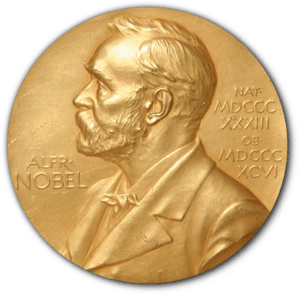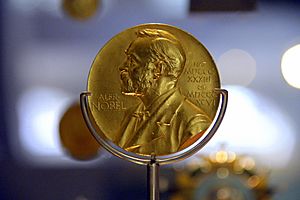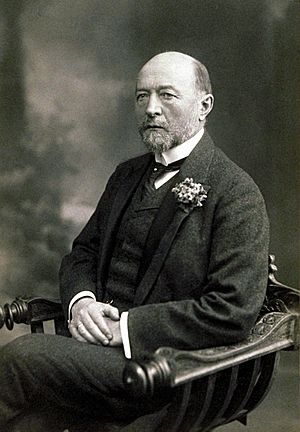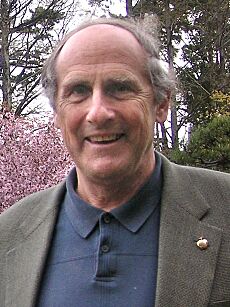Nobel Prize in Physiology or Medicine facts for kids
Quick facts for kids Nobel Prizein Physiology or Medicine |
||||
|---|---|---|---|---|
 |
||||
| Presented by | Nobel Assembly at the Karolinska Institute | |||
| Location | Stockholm, Sweden | |||
| Reward | 11 million SEK (2024) | |||
| First awarded | 1901 | |||
| Last awarded | 2025 | |||
| Currently held by | Mary E. Brunkow, Fred Ramsdell, and Shimon Sakaguchi (2025) | |||
|
||||
The Nobel Prize in Physiology or Medicine is a very special award given each year for amazing discoveries in how our bodies work (physiology) or in medicine. It's one of five Nobel Prizes created by Alfred Nobel, a famous Swedish inventor. He wanted his money to be used to honor people who have done the "greatest benefit to humankind."
The Nobel Prizes are given out every year on December 10th, which is the anniversary of Alfred Nobel's death. As of 2025, 116 Nobel Prizes in Physiology or Medicine have been awarded to 232 scientists. Most winners have been men, but 14 women have also received this important prize.
The very first prize in this category was given in 1901 to Emil von Behring from Germany. He discovered a treatment using blood serum that helped fight diseases like diphtheria. In 1947, Gerty Cori became the first woman to win, for her work on how our bodies use glucose (a type of sugar), which is vital for understanding conditions like diabetes.
The most recent Nobel Prize in Physiology or Medicine was announced on October 6, 2025. It was awarded to Americans Mary E. Brunkow and Fred Ramsdell, and Japanese scientist Shimon Sakaguchi. They were recognized for their discoveries about how our immune system learns to tolerate our own body's cells and the role of special cells called regulatory T cells.
Winners receive a beautiful Nobel Prize medal, a special diploma, and a sum of money. Sometimes, these awards have led to discussions, especially when it comes to who gets credit for a discovery or if a discovery was truly beneficial. For example, a prize given in 1949 for a brain surgery procedure called lobotomy later caused concern because of its serious side effects. Also, a Nobel Prize can only be shared by up to three people, which can be tricky when many scientists work together on a big discovery.
Contents
Who Was Alfred Nobel?
Alfred Nobel was born in Stockholm, Sweden, in 1833. He came from a family of engineers. Alfred was a brilliant chemist, engineer, and inventor. He became very wealthy from his 355 inventions, with dynamite being the most famous.
Nobel was also very interested in how living things work. He even set up his own laboratories in France and Italy. There, he did experiments, like those on blood transfusions. He kept up with new scientific findings and generously supported scientists like Ivan Pavlov in Russia. He believed that scientific discoveries would greatly help humanity.
In 1888, Alfred Nobel was surprised to read his own obituary in a French newspaper. It mistakenly said, "The Merchant of Death Is Dead." It was actually his brother, Ludvig Nobel, who had passed away. However, this made Alfred think about his legacy. He wanted to be remembered for something good.
This event inspired him to change his will. In his last will, Nobel asked that his money be used to create a series of prizes. These prizes would honor those who brought the "greatest benefit on mankind." The prizes were to be in physics, chemistry, peace, physiology or medicine, and literature. Alfred Nobel passed away in 1896 at age 63. His will was approved in 1897.
After Nobel's death, the Nobel Foundation was created to manage his money. The Karolinska Institute in Sweden, a famous medical school, became responsible for choosing the winners of the Prize in Physiology or Medicine. Today, this award is often simply called the Nobel Prize in Medicine.
How Are Winners Chosen?
Alfred Nobel wanted the prize to be given for a "discovery" that brought the "greatest benefit on mankind." Only certain people can suggest individuals for this award. These include members of science academies, professors of medicine in some Nordic countries, and professors from selected universities worldwide. Past Nobel winners can also make nominations.
The Nobel Assembly at the Karolinska Institute, made up of 50 professors, makes the final decision. They choose a special Nobel Committee of five members. This committee carefully reviews all the suggested candidates.
Since 1968, a rule states that no more than three people can share a Nobel Prize. This rule sometimes leads to discussions, especially when large teams of scientists work on important projects.
The committee often chooses researchers who focus on basic science. This means they look for discoveries about how things fundamentally work. For example, the prize for polio vaccines went to scientists who discovered how the virus could grow in lab cells. This basic discovery made the vaccines possible.
What Do Winners Receive?
Winners of the Nobel Prize in Physiology or Medicine receive three things: a gold medal, a diploma, and money. These are given out at a special ceremony in Stockholm, Sweden.
The Nobel Prize Medal

The front of the medal shows a picture of Alfred Nobel. The back of the medal is unique for this prize. It shows the 'Genius of Medicine' holding an open book. She is collecting water from a rock to give to a sick girl. The medal has a Latin phrase that means "It is beneficial to have improved human life through discovered arts." The winner's name and the name of the Karolinska Institute are also on the medal.
The Nobel Prize Diploma
Each Nobel winner receives a unique diploma directly from the King of Sweden. These diplomas are beautifully designed by Swedish artists and calligraphers. The diploma includes a picture and text. It states the winner's name and explains why they received the prize.
The Award Money
Winners also receive a document showing the amount of money they have won. This amount can change each year. If there are two winners, the money is usually split equally. If there are three winners, the committee might split it equally, or give half to one person and a quarter to each of the other two.
The Ceremony and Banquet
The awards are given at a grand ceremony, followed by a fancy dinner called the Nobel Banquet. The menu for this dinner is a big secret until the day of the event! Sweden's royal family, the Prime Minister, and other important guests attend this special occasion. Each winner can invite up to 16 guests.
Famous Winners and Important Discoveries

The first Nobel Prize in Physiology or Medicine went to Emil Adolf von Behring in 1901. His discovery of serum therapy helped doctors fight serious illnesses like diphtheria and tetanus. In 1902, Ronald Ross won for showing how malaria enters the body, identifying the mosquito as the carrier. This helped in fighting the disease worldwide.
Niels Ryberg Finsen won in 1903 for using concentrated light to treat diseases, especially a skin condition called lupus vulgaris. Ivan Pavlov, whose work Alfred Nobel admired, received the prize in 1904 for his studies on how our bodies digest food.
Sometimes, the prize has been given for discoveries that seem a bit outside traditional medicine. For example, in 1973, Nikolaas Tinbergen, Konrad Lorenz, and Karl von Frisch won for their observations of animal behavior. They studied how animals act and learn.

Many women have also made incredible contributions. Gerty Cori was the first woman to win in 1947. As of 2025, 14 women have received this prize, including Mary E. Brunkow in 2025. Only one woman, Barbara McClintock, won the prize by herself for her discovery of "jumping genes" (transposons).
Winners have been recognized for discoveries in many different areas. These include how cells communicate, how our brains and nervous systems work, and how our bodies process food and energy.
When Discoveries Take Time

Sometimes, it takes many years for the importance of a discovery to be fully understood. For example, Barbara McClintock made her discovery about "jumping genes" in 1944, but she didn't receive the prize until 1983. Similarly, Peyton Rous discovered tumor viruses in chickens in 1916, but he won the prize 50 years later in 1966.
Nobel Prizes are usually not given to people who have passed away. However, in 2011, Canadian scientist Ralph M. Steinman was awarded the prize, but the committee didn't know he had died three days before the announcement. Because the decision was made before his death was known, the award was allowed to stand.
Discussions and Challenges
The Nobel Prize is a huge honor, but sometimes there are discussions about who should receive it.
- Sharing Credit: For example, the 1952 prize for streptomycin (a medicine) was given to Selman Waksman. However, his co-discoverer, Albert Schatz, felt he deserved recognition too. This led to a legal case, and Schatz was later officially recognized for his part in the discovery.
- Ethical Concerns: In 1949, António Egas Moniz received the prize for developing a brain surgery called lobotomy. This procedure was later found to have serious negative effects on patients, sometimes causing permanent disability. For instance, Rosemary Kennedy, sister of President John F. Kennedy, underwent this procedure and needed lifelong care. This raised important questions about medical ethics.
- Unrecognized Contributions: The 1962 prize for the structure of DNA went to James D. Watson, Francis Crick, and Maurice Wilkins. However, other scientists like Rosalind Franklin made crucial contributions with her X-ray images of DNA. Sadly, she passed away before the prize was awarded, and Nobel Prizes cannot be given after someone has died. Her story highlights how important it is to recognize everyone's work in science.
- Teamwork Limits: Since 1968, a Nobel Prize can only be shared by a maximum of three people. Today, many big scientific discoveries are made by large teams. This rule means that sometimes, deserving scientists from a larger team might not be able to receive the prize.
Years Without Awards
There have been nine years when the Nobel Prize in Physiology or Medicine was not awarded. Most of these happened during World War I (1914–1918) or World War II (1939–1945). In 1939, Gerhard Domagk was forbidden by his country's government from accepting his prize. He later received the medal and diploma, but not the money.
See also
 In Spanish: Anexo:Ganadores del Premio Nobel de Fisiología o Medicina para niños
In Spanish: Anexo:Ganadores del Premio Nobel de Fisiología o Medicina para niños



